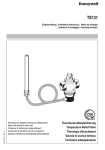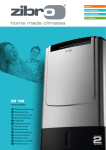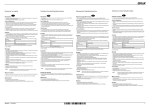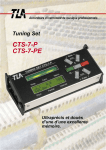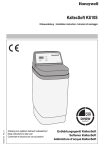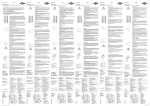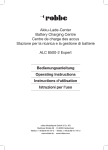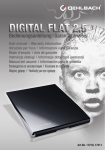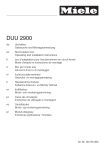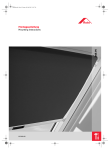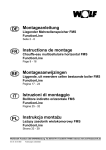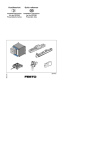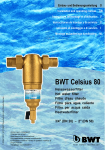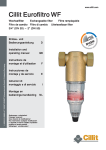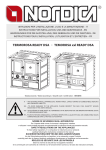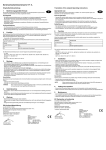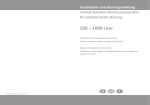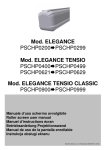Download Einbauanleitung • Installation instructions • Notice - E
Transcript
TS131 EB-TS131 Rev.D Einbauanleitung • Installation instructions • Notice de montage Istruzioni di montaggio • Instrukcja montażu Anleitung zum späteren Gebrauch aufbewahren! Keep instructions for later use! Conserver la notice pour usage ultérieur! Conservare le istruzioni per uso successivo! Zachowa instrukcj do pózniejszego wykorzystania! Thermische Ablaufsicherung Temperature Relief Valve Thermique d'écoulement Valvola di scarico termico Termiczne zabezpieczenie D 1. Sicherheitshinweise ............3 2. Funktionsbeschreibung .......3 3. Verwendung ........................ 3 4. Technische Daten ...............3 5. Lieferumfang .......................4 6. Varianten .............................4 7. Montage ..............................4 8. Instandhaltung..................... 5 9. Entsorgung ..........................5 10.Ersatzteile ........................... 6 17.Maintenance ..................... 13 18.Matériel en fin de vie ........ 14 19.Pièces de rechange .......... 14 I 1. Avvertenze di sicurezza .... 15 20.Descrizione del funzionamento .................. 15 21.Uso ................................... 15 22.Dati tecnici ........................ 15 23.Fornitura ........................... 16 24.Varianti ............................. 16 25.Montaggio ......................... 16 26.Manutenzione ................... 17 27.Smaltimento ...................... 17 28.Ricambi ............................. 18 GB 1. Safety Guidelines ................7 2. Functional description .........7 3. Application ...........................7 4. Technical data .....................7 5. Scope of delivery .................7 6. Options ................................8 7. Assembly .............................8 8. Maintenance ........................9 9. Disposal ..............................9 10.Spare Parts .......................10 PL 1. Wskazówki bezpieczenstwa ................. 19 29.Opis funkcji ....................... 19 30.Zastosowanie ................... 19 31.Dane techniczne ............... 19 32.Zakres dostawy ................ 20 33.Warianty ........................... 20 34.Montaz............................... 20 35.Utrzymywanie w dobrym stanie ................................ 21 36.Usuwanie.......................... 22 37.CzÍúci zamienne ............... 22 F 1. Consignes de sécurité .......11 11.Description fonctionnelle ... 11 12.Mise en oeuvre ..................11 13.Caractéristiques ................ 12 14.Contenu de la livraison...... 12 15.Variantes ...........................12 16.Montage ............................ 12 MU1H-1543GE23 R0709 2 Honeywell GmbH D 1. Sicherheitshinweise 1. Beachten Sie die Einbauanleitung. 2. Benutzen Sie das Gerät • bestimmungsgemäß • in einwandfreiem Zustand • sicherheits- und gefahrenbewusst. 3. Beachten Sie, dass das Gerät ausschließlich für den in dieser Einbauanleitung genannten Verwendungsbereich bestimmt ist. Eine andere oder darüber hinausgehende Benutzung gilt als nicht bestimmungsgemäß. 4. Beachten Sie, dass alle Montage-, Inbetriebnahme, Wartungs- und Justagearbeiten nur durch autorisierte Fachkräfte ausgeführt werden dürfen. 5. Lassen Sie Störungen, welche die Sicherheit beeinträchtigen können, sofort beseitigen. 2. Funktionsbeschreibung Die thermische Ablaufsicherung wird von der Vorlauftemperatur des Wärmeerzeugers gesteuert. Sie besteht aus einem federbelasteten Ventil und einem Temperaturfühler, der auf ein Balgsystem wirkt. Bei Erreichen einer VorlaufMU1H-1543GE23 R0709 temperatur im Heizkessel von 95 °C wird die Kraft im Balgsystem größer als die Federkraft des Ventiles, und das Ventil öffnet. Dadurch wird erwärmtes Trinkwasser abgeführt und durch kaltes aus dem Netz ersetzt. Dieses kann nun die überschüssige Wärme aus dem Wassererwärmer aufnehmen und eine Überhitzung verhindern. 3. Verwendung Wechselbrandkessel mit eingebautem Wassererwärmer oder Kühlschlange in geschlossenen, mit festen Brennstoffen beheizten Heizungsanlagen nach EN 12828 4. Technische Daten Leistungen der max. 100 kW Heizungsanlagen Öffnungstem- 95 °C peratur Leistung 2800 kg/h Wasser bei einem Druckabfall von ∆p=1 bar (Eingangsdruck 5bar; Ausgangsdruck 4bar) (1 Fühler) AnschlussRp 3/4" (DIN EN 10226) größe Betriebsdruck max. 5 bar 3 Honeywell GmbH D 5. Lieferumfang Die thermische Ablaufsicherung besteht aus: • Gehäuse mit Innengewinde • Haube • Ventilkegel mit Formdichtung • Feder • Externer Doppeltemperaturfühler mit Kapillarrohr • Tauchhülse G 1/2" (ISO 228) 6. Varianten TS131-3/4A Öffnungstemperatur 95 °C Kapillarrohr mit Schutzrohr 1300 mm bauteilgeprüft TS131-3/4B Öffnungstemperatur 95 °C Kapillarrohr mit Schutzrohr 4000 mm TS131-3/4Z Sonderausführung auf Anfrage 7. Montage 7.1 Einbauhinweise • Der Einbau des Ventiles und des Fühlers ist sorgfältig vorzunehmen, damit Beschädigungen des Kapillarrohres vermieden werden • Die Mündung der Ausblaseleitung muss frei und beobachtbar sein MU1H-1543GE23 R0709 4 • Personen dürfen beim Abblasen der Armatur nicht gefährdet werden • Es ist eine ausreichend bemessene Ablaufleitung vorzusehen kvs-Werte ∆p = 1 bar 3 m3/h bei 2 unversehrten Fühlersystemen 2,1 m3/h bei einem Fühlersystem Achtung! Der Einbau der thermischen Ablaufsicherung ersetzt nicht das Membran-Sicherheitsventil in der Kaltwasser-Zuführungsleitung zum Wassererwärmer. 7.2 Montageanleitung 1. Thermische Ablaufsicherung entsprechend dem Einbauschema in die Warmwasserleitung einbauen - Durchflussrichtung ist durch Pfeil gekennzeichnet 2. Wärmefühler bis zum Anschlag in das Tauchrohr einschieben und mit der Rundkopfschraube gegen Herausziehen sichern Honeywell GmbH D 7.3 Inbetriebnahme Bei Inbetriebnahme der Heizungsanlage muss der Ersteller der Anlage die einwandfreie Funktion der thermischen Ablaufsicherung überprüfen. 8. Instandhaltung Wir empfehlen einen Wartungsvertrag mit einem Installationsunternehmen abzuschließen 8.1 Inspektion und Wartung • Entsprechend den Forderungen der DIN EN 12828 ist der Betreiber der Anlage verpflichtet, die thermische Ablaufsicherung mindestens einmal jährlich durch einen Fachkundigen auf ihre Funktionsbereitschaft prüfen zu lassen. • Durchführung durch ein Installationsunternehmen 1. Prüfen ob Wasser aus dem Gehäuse austritt - tritt Wasser aus müssen die Dichtungen (Kolbenführung komplett) ersetzt oder das Gerät gegebenfalls ausgetauscht werden MU1H-1543GE23 R0709 2. Kontrollkappe betätigen und prüfen ob zunächst Wasser abläuft und das Ventil anschließend wieder schließt - tritt kein Wasser aus oder schließt das Ventil nicht muss das Gerät gegebenfalls ausgetauscht werden 8.2 Reinigung • Durchführung durch ein Installationsunternehmen • Durchführung durch den Betreiber Zum Reinigen der Kunststoffteile keine lösungsmittel- und alkoholhaltige Reinigungsmittel benutzen! Es dürfen keine Reinigungsmittel in die Umwelt oder Kanalisation gelangen! 9. Entsorgung • Gehäuse, Haube und Tauchhülse aus Messing • Temperaturfühler aus Kupfer • Kapillarrohr aus Kupfer • Ventilkegel aus Messing • Dichtungen aus heißwasserbeständigem Elastomer Die örtlichen Vorschriften zur ordnungsgemäßen Abfallverwertung bzw. Beseitigung beachten! 5 Honeywell GmbH D 10.Ersatzteile TS131TWG TS131KF TS131KF-3/4 Kolbenführung komplett für TS131 Anschlußgröße 3/4" TS131TWG-3/4 Temperaturweggeber für TS131 Öffnungstemperatur 95°C Variante A = Kapillarrohr mit Schutzrohr 1300 mm Variante B = Kapillarrohr mit Schutzrohr 4000 mm Einbauschema min. DN20 (3/4“) MU1H-1543GE23 R0709 6 Honeywell GmbH GB 1. Safety Guidelines 1. Follow the installation instructions. 2. Use the appliance • according to its intended use • in good condition • with due regard to safety and risk of danger. 3. Note that the appliance is exclusively for use in the applications detailed in these installation instructions. Any other use will not be considered to comply with requirements and would invalidate the warranty. 4. Please take note that any assembly, commissioning, servicing and adjustment work may only be carried out by authorized persons. 5. Immediately rectify any malfunctions which may influence safety. 2. Functional description The temperature relief valve is actuated by the flow temperature of the heat generator. It comprises a spring-loaded valve and a bellows operated temperature sensor. When a boiler flow temperature of 95ºC is reached the force exerted by the bellows system MU1H-1543GE23 R0709 becomes greater than the force of the spring and the valve opens. Heated potable water then flows out and this is replaced by cold water from the supply network. This absorbs excess heat from the heat generator and prevents overheating. 3. Application Multi-fuel boilers with integral water heating or condensing coils in closed solid-fuel fired heating systems to EN 12828. 4. Technical data Heating system max. 100 kW capacity Opening 95 °C temperature Flow capacity 2800 kg/h water at the pressure drop ∆p=1 bar (Inlet pressure 5bar; Outlet pressure 4bar) (1 capillary tube) Connection Rp 3/4" (DIN EN 10226) size Operating pres-max. 5 bar sure 5. Scope of delivery The temperature relief valve comprises: • Housing with internal thread 7 Honeywell GmbH GB • • • • Bonnet Valve piston with seal disc Spring Remote double temperature sensor with capillary tube • Immersion pocket G 1/2” (ISO 228) 6. Options TS131-3/4A Opening temperature 95 °C capillary tube with protection sheath 1300 mm, with approved construction TS131-3/4B Opening temperature 95 °C capillary tube with protection sheath 4000 mm TS131-3/4Z Special Versions available on request 7. Assembly 7.1 Installations Guidelines • The valve and the sensor must be installed carefully to avoid any damage to the capillary tube • The opening on the blow-out line must be clear and easy to monitor • Ensure no persons are in danger when blowing off the valve MU1H-1543GE23 R0709 8 • A sufficiently dimensioned discharge line must be provided kvs-values ∆p = 1 bar 3 m3/h with 2 intact sensor systems 2.1 m3/h with one sensor system Attention! Installation of the thermal discharge safety valve does not replace the diaphragm relief value in the cold water supply line to the water heater. 7.2 Assembly instructions 1. Install a thermal discharge safety valve into the hot water line according to the installation diagram - Flow direction is marked by an arrow 2. Push the heat sensor into the immersion pipe up to the stop point and secure with a round screw to stop it being pulled out 7.3 Commissioning On commissioning the heating system, the person preparing the system must check that the thermal discharge safety valve is functioning perfectly. Honeywell GmbH GB 8. Maintenance We recommend a planned maintenance contract with an installation company 8.1 Inspection and Maintenance • According to the requirements of DIN EN 12828, the system operator is obliged to have the thermal discharge safety valve checked by a professional at least once a year to ensure its functioning capacity. • To be carried out by an installation company 1. Check whether water is escaping from the housing - if water is escaping, the seals (piston guide complete) must be replaced or if necessary the unit must be replaced 2. Operate the check valve and first check if water is running off, then close the valve again - if no water is escaping or the valve does not close, the unit may have to be replaced MU1H-1543GE23 R0709 8.2 Cleaning • To be carried out by an installation company • To be carried out by the operator Do not use any cleaning agents containing solvents or alcohol to clean the plastic parts! Detergents must not be allowed to enter the environment or the sewerage system! 9. Disposal • Brass housing, bonnet and immersion pocket • Copper temperature sensor • Copper capillary tube • Brass valve piston • Hot-water-resistant elastomer seals 9 Honeywell GmbH GB 10.Spare Parts TS131TWG TS131KF TS131KF-3/4 Piston guide complete for TS131 Connection size 3/4" TS131TWG-3/4 Temperature motion transducer for TS131 Opening temperature 95°C Option A = Capillary tube with protection sheath 1300 mm Option B = Capillary tube with protection sheath 4000 mm Installation diagram min. DN20 (3/4“) MU1H-1543GE23 R0709 10 Honeywell GmbH F 1. Consignes de sécurité 1. Suivre les indications de la notice de montage. 2. En ce qui concerne l'utilisation de l'appareil • Utiliser cet appareil conformément aux données du constructeur • Maintenir l'appareil en parfait état • Respectez les consignes de sécurité 3. Il faut noter que cet équipement ne peut être mis en oeuvre que pour les conditions d'utilisation mentionnées dans cette notice. Toute autre utilisation, ou le non respect des conditions normales d'utilisation, serait considérée comme non conforme. 4. Observer que tous les travaux de montage, de mise en service, d'entretien et de réglage ne pourront être effectués que par des spécialistes autorisés. 5. Prendre des mesures immédiates en cas d'anomalies mettant en cause la sécurité. MU1H-1543GE23 R0709 2. Description fonctionnelle Le sécurité thermique d'écoulement est commandée par la température aller du radiateur. Elle se compose d'une valve à ressort et d'un thermocapteur qui agit sur un système à soufflet. Lorsque la température aller dans la chaudière a atteint 95ºC, la force dans le système à soufflet est plus grande que celle du ressort et la valve s'ouvre. L'eau potable chaude peut alors s'écouler et est remplacée par l'eau froide du réseau. Celle-ci peut alors absorber la chaleur excédentaire de la chaudière et empêcher une surchauffe. 3. Mise en oeuvre Les chaudières mixtes avec chauffe-eau intégré ou serpentin dans un système de chauffage fermé avec combustible solide selon la norme EN 12828 11 Honeywell GmbH F 4. Caractéristiques 6. Variantes Puissances de max. 100 kW l'installation de chauffage Température 95 °C d'ouverture Débit 2800 kg/h d’eau pour une perte de charge ∆p=1 bar (Pression d’entrée 5bar; Pression de sortie 4bar) (1 tube capillaire) Dimensions de Rp 3/4" raccordement (DIN EN 10226) Pression de max. 5 bar service TS131-3/4A Température d'ouverture 95º C Tube capillaire avec protection 1300 mm testé TS131-3/4B Température d'ouverture 95º C Tube capillaire avec protection 4000 mm TS131-3/4Z Exécution spéciale sur demande 5. Contenu de la livraison La sécurité thermique d'écoulement se compose de : • Boîtier avec filetage intérieur • Capot • Cône de soupape avec joint • Ressort • Thermocapteur double externe avec tube capillaire • Douille d'immersion G 1/2" (ISO 228) MU1H-1543GE23 R0709 7. Montage 7.1Dispositions à prendre • Le montage de la soupape et du capteur doit être effectué prudemment afin de ne pas endommager le tube capillaire. • L'embouchure de la conduite de sortie doit être libre et observable • Les personnes ne doivent pas être mises en danger par le crachement de la robinetterie • Il convient de prévoir une conduite d'écoulement suffisante Valeurs kvs∆p = 1 bar avec 2 systèmes intacts 3 m3/h de capteurs 2.1 m3/h avec un système de capteurs 12 Honeywell GmbH F 8.1Inspection et Maintenance • En accord avec la DIN EN 12828, l'exploitant de l'installation s'oblige à faire contrôler le fonctionnement de la sécurité thermique d'écoulement une fois par an par du personnel spécialisé. • Réalisation par une entreprise d'installation 1. Contrôlez si l'eau sort du boîtier - Si de l'eau fuit, alors les joints (guide des pistons complet) doivent être remplacés ou éventuellement l'appareil échangé 2. Actionnez le clapet de contrôle et contrôlez d'abord si l'eau coule et si la soupape ensuite se referme. - Si l'eau ne coule pas ou si la soupape ne se referme pas, alors l'appareil doit être échangé 8.2Nettoyage • Réalisation par une entreprise d'installation • Réalisation par l'exploitant Attention ! Le montage de la sécurité thermique d'écoulement ne remplace pas la soupape de sécurité à membrane dans la conduite d'alimentation d'eau froide vers le chauffe-eau. 7.2Instructions de montage 1. Montez la sécurité thermique d'écoulement, selon le plan de montage, dans la conduite d'eau chaude - La direction du courant est marquée par une flèche 2. Glissez les thermocapteur dans la douille d'immersion jusqu'à la butée et sécurisez avec une vis à tête ronde 7.3Mise en service Lors de la mise en service de l'installation de chauffage, le constructeur du système doit contrôler le fonctionnement parfait de la sécurité thermique d'écoulement. 8. Maintenance Nous recommandons de conclure un contrat d'entretien avec un installateur MU1H-1543GE23 R0709 Ne pas utiliser de détergents contenant des solvants ou de l'alcool pour nettoyer les parties en plastique! 13 Honeywell GmbH F • Cône de soupape en laiton • Joints en élastomère résistant à l'eau chaude Se conformer à la réglementation pour l'élimination des équipements industriels en fin de vie vers les filières de traitement autorisées! Ne pas rejeter de produit détergent dans l'environnement ou dans les canalisations! 9. Matériel en fin de vie • Boîtier, capot et douille d'immersion en laiton • Thermocapteur en cuivre • Tube capillaire en cuivre 10.Pièces de rechange TS131TWG TS131KF TS131KF-3/4 Guide des pistons complet pour TS 131 Taille des raccords 3/4" TS131TWG-3/4 Capteur de position de température pour TS 131 Température d'ouverture 95 ºC variante A = tube capillaire avec tube de protection 1300 mm Variante B = Tube capillaire avec protection 4000 mm Plan de montage min. DN20 (3/4“) MU1H-1543GE23 R0709 14 Honeywell GmbH I 1. Avvertenze di sicurezza 1. Rispettare le istruzioni di montaggio. 2. Utilizzare l'apparecchio • secondo la destinazione d'uso • solo se integro • in modo sicuro e consapevoli dei pericoli connessi 3. Si prega di considerare che l'apparecchio è realizzato esclusivamente per il settore d'impiego riportato nelle presenti istruzioni d'uso. Un uso differente o diverso da quello previsto è da considerarsi improprio. 4. Osservare che tutti i lavori di montaggio, di messa in funzione, di manutenzione e di regolazione devono essere eseguiti soltanto da tecnici specializzati e autorizzati. 5. I guasti che potrebbero compromettere la sicurezza devono essere risolti immediatamente. 2. Descrizione del funzionamento La valvola di scarico termico viene controllata dalla temperatura di mandata del generatore di calore. E' composta da una valvola caricata a molla e da un sensore di temperatura che agisce sul MU1H-1543GE23 R0709 sistema a soffietto. Raggiungendo una temperatura di mandata di 95°C nella caldaia, la forza nel sistema a soffietto supera la forza della molla della valvola e la valvola si apre. Così l'acqua potabile riscaldata viene condotta via e sostituita da acqua fredda della rete. Questa può quindi assorbire il calore in eccesso prodotto dallo scaldaacqua ed evitare un surriscaldamento. 3. Uso Caldaia mista con generatore di calore montato o serpentina di raffreddamento in impianti di riscaldamento a circuito chiuso riscaldati con combustibili solidi secondo la norma EN 12828. 4. Dati tecnici Prestazioni max. 100 kW degli impianti di riscaldamento Temperatura di 95°C apertura Prestazione 2100 kg/h di acqua con una pressione di entrata minima di 1,0 bar (pressione in ingresso 5 bar; pressione in uscita 4 bar) (1 sensore) 15 Honeywell GmbH I Dimensioni Rp 3/4" (DIN EN 10226) attacchi Pressione di Max. 5 bar esercizio 5. Fornitura La valvola di scarico termico è composta da: • corpo con filettatura interna • copertura • cono della valvola con guarnizione sagomata • molla • doppio sensore di temperatura esterno con tubo capillare • Bussola a immersione G1/2" (ISO 228) 6. Varianti TS131-3/4A Temperatura di apertura 95°C Tubo capillare con guaina protettiva da 1300 mm, con struttura controllata TS131-3/4B Temperatura di apertura 95° C Tubo capillare con guaina protettiva da 4000 mm TS131-3/4Z Dotazione speciale su richiesta 7. Montaggio 7.1 Istruzioni di installazione • Il montaggio della valvola e del sensore deve essere eseguito con attenzione per evitare danni MU1H-1543GE23 R0709 al tubo capillare • La bocca del tubo di scarico deve essere libera e visibile • Non mettere in pericolo le persone durante lo scarico della valvola • Prevedere un tubo di scarico della misura adeguata Valorikvs ∆p = 1 bar 3 m3/h con due sistemi di sensori integri 2,1 m3/h con un sistema di sensori Attenzione! Il montaggio della valvola di scarico termico non sostituisce la valvola di sicurezza a membrana nella condotta di alimentazione dell'acqua fredda verso il generatore dell'acqua. 7.2 Istruzioni di montaggio 1. Montare la valvola di scarico termico nella condotta dell'acqua calda secondo lo schema di montaggio - La direzione di flusso è indicata dalla freccia 2. Inserire il termorivelatore nel tubo ad immersione fino all'arresto e assicurarlo con la vite a testa tonda in modo che non esca 16 Honeywell GmbH I 7.3 Messa in funzione Al momento della messa in funzione dell'impianto di riscaldamento, il realizzatore dell'impianto deve controllare che il funzionamento della valvola di scarico termico sia perfetto. 8. Manutenzione Consigliamo di stipulare un contratto di manutenzione con un'azienda di installazione 8.1 Ispezione e manutenzione • Secondo i requisiti della norma DIN EN 12828, il responsabile dell'impianto è tenuto a far controllare la funzionalità della valvola di scarico termico almeno una volta all'anno da personale specializzato. • attraverso un'azienda di installazione 1. Controllare se fuoriesce acqua dal corpo - se fuoriesce acqua, sostituire la guarnizione (completamente la guida del pistone) o se necessario sostituire l'apparecchio 2. Azionare il coperchio di controllo e controllare prima se MU1H-1543GE23 R0709 l'acqua scorre e poi se la valvola si richiude - se l'acqua non fuoriesce o se la valvola non si chiude, sostituire l'apparecchio se necessario 8.2 Pulizia • attraverso un'azienda di installazione • attraverso l'esercente Per pulire le parti in plastica, non utilizzare detergenti contenenti solventi e alcol! Nell'ambiente o nella canalizzazione è necessario che non venga scaricato alcun detergente! 9. Smaltimento • Corpo, copertura e boccola ad immersione in ottone • Sensore della temperatura in rame • Tubo capillare in rame • Cono della valvola in ottone • Guarnizioni in elastomero resistente all'acqua calda Rispettare le norme locali relative al riciclaggio o allo smaltimento a regola d'arte di rifiuti! 17 Honeywell GmbH I 10.Ricambi TS131TWG TS131KF TS131KF-3/4 Guida del pistone completa per TS131 Misura del raccordo 3/4" TS131TWG-3/4 Sensore di variazione della temperatura per TS131 Temperatura di apertura 95°C Variante A = tubo capillare con guaina protettiva 1300 mm Variante B = tubo capillare con guaina protettiva da 4000 mm Schema di montaggio min. DN20 (3/4“) MU1H-1543GE23 R0709 18 Honeywell GmbH PL 1. Wskazówki bezpieczeństwa 1. Przestrzegać instrukcji montażu. 2. Proszę użytkować przyrząd - zgodnie z jego przeznaczeniem - w nienagannym stanie - ze świadomością bezpiec zeństwa i zagrożeń 3. Proszę uwzględnić, że przyrząd przeznaczony jest wyłącznie dla zakresu zastosowania określo nego w niniejszej instrukcji montażu. Każde inne lub wykraczające poza to użytko wanie uznawane jest jako niez godne z przeznaczeniem. 4. Proszę uwzględnić, że wszystkie prace montażowe mogą być wykonywane tylko przez autoryzowany personel fachowy. 5. Wszystkie te zakłócenia, które mogą naruszyć bezpieczeństwo należy natychmiast usunąć. MU1H-1543GE23 R0709 2. Opis funkcji Termiczne zabezpieczenie odpływowe jest zaworem urucha mianym temperaturą czynnika na wylocie ze źródła ciepła. Składa się ono z zaworu sprężynowego oraz czujnika temperatury działającego na układ miechowy. Gdy temperatura w kotle grzew czym osiągnie 95 °C siła w układzie miechowym jest większa niż nacisk sprężyny, co powoduje otwarcie zaworu. W ten sposób zostaje odprowadzona podgrzana wodna pitna i zastąpiona poprzez zimną z sieci. Przejmuje ona nadmiar ciepła z podgrzewacza wody i zapobiega tym samym przegrzaniu. 3. Zastosowanie Kotły ze zintegrowanym podgrze waczem wody lub wężownicą schładzającą stosowane w zamkniętych instalacjach grzewc zych na paliwa stałe wg normy EN 12828 19 Honeywell GmbH PL 4. Dane techniczne Moc maks. 100 kW instalacji grzewczej Tempera 95 °C tura otwarcia Przepływ 2800 kg/h wody przy spadku ciśnienia ∆p=1 bar (Ciśnienie wejś ciowe 5 bar; Ciśnienie wyjściowe 4 bar) (1 rurka kapilarna). Rozmiar Rp 3/4" przyłącza (DIN EN 10226) Ciśnienie maks 5 bar robocze MU1H-1543GE23 R0709 20 5. Zakres dostawy Zabezpieczenie termiczne składa się: - Korpus z gwintem wewnętrznym - Osłona - Grzybek zaworu z profilowanym uszczelnieniem - Sprężyna - Zewnętrzny podwójny czujnik temperatury z rurką kapilarną - Tulejka zanurzeniowa G 1/2" (ISO 228) 6. Warianty TS131-3/4A Temperatura otwarcia 95 °C Rurka kapilarna z rurką ochronną 1300 mm certyfikowana TS131-3/4B Temperatura otwarcia 95 °C Rurka kapilarna z rurką ochronną 4000 mm TS131-3/4Z Wersje specjalne na zamówienie Honeywell GmbH PL 7. Montaż 7.1 Montaż - Montaż zaworu oraz czujnika należy przeprowadzić w staranny sposób, tak by nie uszkodzić rurki kapi larnej - Wylot przewodu wydmuchowego nie może być zatkany i musi być widoczny - Wydmuchiwanie armatury nie może stanowić zagrożenia dla osób - Należy zastosować przewód odprowadzający od odpowied nich wymiarach 7.2 Instrukcja montażu 1. Termiczne zabezpieczenie odpływowe należy zamontować w przewodzie ciepłej wody zgodnie ze schematem montażowym - Kierunek przepływu oznac zono strzałką 2. Czujnik termiczny wsunąć do oporu w rurkę zanurzeniową zabezpieczyć przed wyciagnię ciem śrubą 7.3 Rozpoczęcie eksploatacji Przed oddaniem instalacji do użytku wykwalifi kowany insta lator powinien sprawdzić popraw ność działania zabez pieczenia termicznego. kvs-wartości ∆p = 1 bar 3 m3/h przy 2 sprawnych systemach czujników 2.1 m3/h przy jednym systemie czujników 8. Utrzymywanie w dobrym stanie Zalecamy zawarcie umowy konserwacyjnej z odpowiednią firmą instalacyjną¶ Uwaga! Montaż zabezpieczenia termicznego nie zastępuje przeponowego zaworu bezpiec zeństwa w układzie doprowadzającym wodę zimną do podgrzewacza wody. MU1H-1543GE23 R0709 21 Honeywell GmbH PL 8.1 Inspekcja i Konserwacja - Zgodnie z wymogami normy DIN EN 12828 użytkujący instalację ma obowiązek zlecić wykwalifikowanemu instalatorowi przynajm niej raz w roku kontrolę poprawności działania zabezpieczenia termicz nego. - Kontrolę powinna przepro wadzić firma insta latorska 1. Należy sprawdzić, czy z korpusu nie wycieka woda - w przypadku wycieku wody należy wymienić uszc zelnienia (zespół tłoka komplet) lub w razie potrzeby całe urządzenie 2. Uruchomić pokrywę kontrolną i sprawdzić czy odpływa woda a zawór następnie ponownie zamyka - jeżeli nie wypływa woda lub zawór nie zamyka urządzenie należy wymienić MU1H-1543GE23 R0709 8.2 Czyszczenie - Kontrole powinna przepro wadzić firma instalatorska. - Przeprowadzane przez użytkującego Do czyszczenia czÍúci z tworzywa sztucznego nie uřywaĘ úrodkŰw do czyszc zenia, zawierajĽcych rozpusz czalniki i alkohol! Żadne środki czyszczące nie powinny dostać się do środo wiska naturalnego lub kanali zacji! 9. Usuwanie - Korpus, osłona i tulejka zanurzeniowa z mosiądzu - Czujnik temperatury z miedzi - Rurka kapilarna z miedzi - Grzybek zaworu z mosiądzu - Uszczelnienia z odpornych na działanie gorącej wody elasto merów Należy stosować się do miejs cowych przepisów dotyczących prawidłowego wykorzystania odpadów wzgl. ich usuwania! 22 Honeywell GmbH PL 10.Części zamienne TS131TWG TS131KF TS131KF-3/4 Zespół tłoka - komplet do TS131 Rozmiar przyłącza 3/4" TS131TWG-3/4 Termostat TS131 Temperatura otwarcia 95 °Cwersja A = rurka kapilarna z rurką ochronną 1300 mm wersja B = rurka kapilarna z rurką ochronną 4000 mm Schematem montażowym min. DN20 (3/4“) MU1H-1543GE23 R0709 23 Honeywell GmbH Automation and Control Solutions Manufactured for and on behalf of the Honeywell GmbH Environmental and Combustion Controls Division of HoHardhofweg neywell Technologies Sàrl, Rolle, Z.A. La Pièce 16, D-74821 Mosbach Switzerland by its Authorised Representative Honeywell GmbH Phone: (49) 6261 810 Fax: (49) 6261 81309 MU0H-1543GE23 R0709 http://europe.hbc.honeywell.com Subject to change © 2009 Honeywell GmbH www.honeywell.com
























